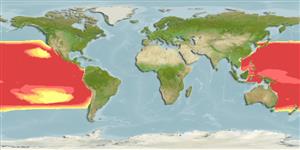分類 / Names
共通名の | 類義語 | Catalog of Fishes(部類, 種) | ITIS | CoL | WoRMS | Cloffa
>
Lophiiformes (Anglerfishes) >
Linophrynidae (Leftvents)
Etymology: Linophryne: Greek, 'linon' = flax or anything made of flax such as "cord," "rope," or a "net" + Greek, 'phryne' = "toad" (refers to a toadlike fish that fishes with a net) (Ref. 86949).
Environment: milieu / climate zone / depth range / distribution range
生態学
海 深海浮遊性; 深さの範囲 150 - 2000 m (Ref. 86949). Deep-water
Indo-Pacific.
サイズ / 重さ / 年齢
Maturity: Lm ? range ? - ? cm
Max length : 4.3 cm SL オス/雌雄の選別がない; (Ref. 27311)
Metamorphosed females distinguished by the following characteristics: escal bulb with distal pair of fringed anterior filaments; medial distal papilla with short filaments present; one or two pairs of stout distal posterior filaments; simple tapering appendage emerging from behind escal pore; barbel with short, stout, undivided stem, length 10-17% SL to base of series of 5-6 short branches, each with a number of branched filaments at distal tip; filaments and transparent distal part of primary branches with numerous, small, globular luminous organs, internal, sessile, or set on short stalks; lower jaw without symphisial spine. Males without pointed sphenotic spines. Larvae, males and juvenile female with two lateral rows of large subdermal melanophores along side of body, with concentration at base of caudal fin (Ref. 86949).
Also mesopelagic (Ref. 7300).
Life cycle and mating behavior
Maturities | 繁殖 | Spawnings | Egg(s) | Fecundities | 幼生
Paxton, J.R., D.F. Hoese, G.R. Allen and J.E. Hanley, 1989. Pisces. Petromyzontidae to Carangidae. Zoological Catalogue of Australia, Vol. 7. Australian Government Publishing Service, Canberra, 665 p. (Ref. 7300)
Human uses
用具
特記事項
XMLをダウンロードして下さい
インターネットの情報源
Estimates based on models
Preferred temperature (Ref.
123201): 4.2 - 11.1, mean 6.7 °C (based on 507 cells).
Phylogenetic diversity index (Ref.
82804): PD
50 = 0.5000 [Uniqueness, from 0.5 = low to 2.0 = high].
Bayesian length-weight: a=0.01000 (0.00244 - 0.04107), b=3.04 (2.81 - 3.27), in cm total length, based on all LWR estimates for this body shape (Ref.
93245).
栄養段階 (Ref.
69278): 3.4 ±0.6 se; based on size and trophs of closest relatives
Fishing Vulnerability (Ref.
59153): Low vulnerability (10 of 100).
